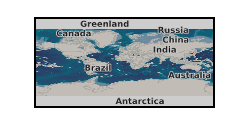Sedimentary history
Type of resources
Topics
Keywords
Contact for the resource
Provided by
Years
Formats
Representation types
Update frequencies
-

This dataset comprises 35 samples analysed for clay mineralogy from IODP Expedition 374 Site U1521 to the Ross Sea, collected on the RV JOIDES Resolution. Shipboard biostratigraphy and magnetostratigraphy suggests the samples are mainly early Miocene in age (McKay et al., 2019, Proceedings of the International Ocean Discovery Program). The uppermost samples do, however, include younger Plio-Pleistocene sediments.
-

This dataset comprises neodymium (Nd) and strontium (Sr) isotope compositions measured on 72 sediment samples, from IODP Expedition 374 Site U1521 to the Ross Sea. These were collected on the RV JOIDES Resolution. Shipboard biostratigraphy and magnetostratigraphy suggests the samples are mainly early Miocene in age (McKay et al., 2019). The uppermost samples do, however, include younger Plio-Pleistocene sediments. Neodymium and Sr isotope analyses were conducted using a multi-collector inductively coupled plasma mass spectrometer (MC-ICP-MS) and a thermal ionisation mass spectrometer (TIMS), respectively, in the MAGIC laboratories at Imperial College London. Neodymium and Sr isotopes in sediments can be compared to measurements from terrestrial rock samples, allowing the changing provenance of the sediments to be traced. This dataset therefore provides information on how erosion by Antarctica’s ice sheets bordering the Ross Sea has changed over time. Neodymium isotopes are reported in the epsilon notation, which denotes the deviation in parts per 10,000 from the present-day composition of the Chondritic Uniform Reservoir (143Nd/144Nd = 0.512638) (Jacobsen and Wasserburg, 1980).
-

This dataset comprises zircon U-Pb data on 11 samples, each containing ~90-150 individual grains. This method was applied to sediment samples from IODP Expedition 374 Site U1521 to the Ross Sea, collected on the RV JOIDES Resolution. Shipboard biostratigraphy and magnetostratigraphy suggests the samples are mainly early Miocene in age (McKay et al., 2019). The uppermost samples do, however, include younger Plio-Pleistocene sediments. Samples were measured using an Agilent 7900 laser ablation inductively-coupled plasma mass spectrometer (LA-ICP-MS) with a 25-35 µm pit diameter in the London Geochronology Centre at University College London.
-

This dataset comprises 40Ar/39Ar dated detrital hornblende grains for 5 samples from IODP Expedition 374 Site U1521 to the Ross Sea, collected on the RV JOIDES Resolution. Shipboard biostratigraphy and magnetostratigraphy suggests the samples are early Miocene in age (McKay et al., 2019, Proceedings of the International Ocean Discovery Program). These data can be compared to terrestrial geochronological data, allowing the changing provenance of the sediments to be traced.
-

The thermal state of marine sediments controls a range of potential dehydration reactions as sediments are subducted. In thick sediment sections it is possible that reactions that would normally occur within a subduction zone start offshore of the deformation front. This scenario may be occurring at the Sumatra subduction zone (e.g. Geersen et al., 2013; Huepers et al., 2017). We have investigated this possibility by modelling the thermal and depth history of sediments offshore Sumatra. We have used a range of different assumptions about how the sediments decompact with depth, as well as testing the dependence on the seismic velocities used for depth conversion of the horizons.
-

This dataset comprises continuous logging of clasts >2 mm from International Ocean Discovery Program Expedition 374 Site U1521 to the Ross Sea, collected on the RV JOIDES Resolution. Shipboard biostratigraphy and magnetostratigraphy suggests the sediments are early Miocene in age (McKay et al., 2019, Proceedings of the International Ocean Discovery Program). Logged clasts are grouped by core into seven main lithological groups: igneous rocks, quartz fragments, dolerites, volcanic rocks, metamorphic rocks, sedimentary rocks and sedimentary intraclasts. A full methods description is provided at the bottom of the data file. The clast abundances can be compared to knowledge of terrestrial geology, allowing the changing provenance of the sediments to be traced.
 NERC Data Catalogue Service
NERC Data Catalogue Service